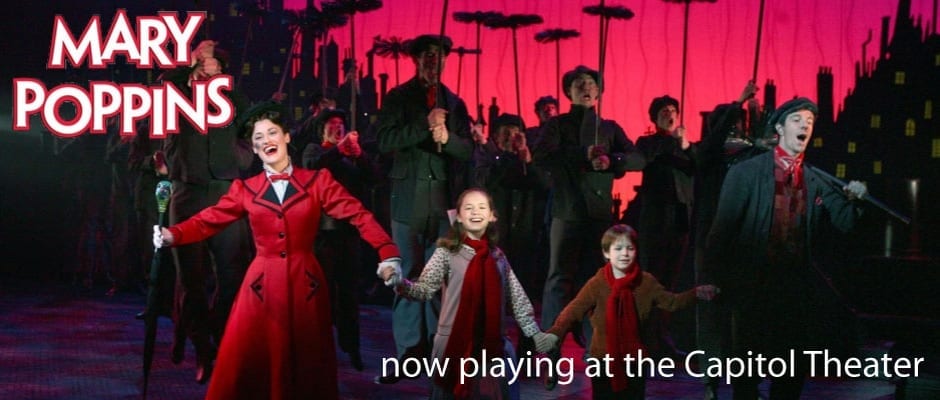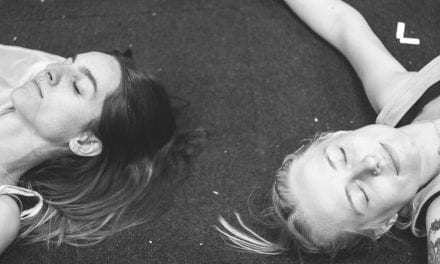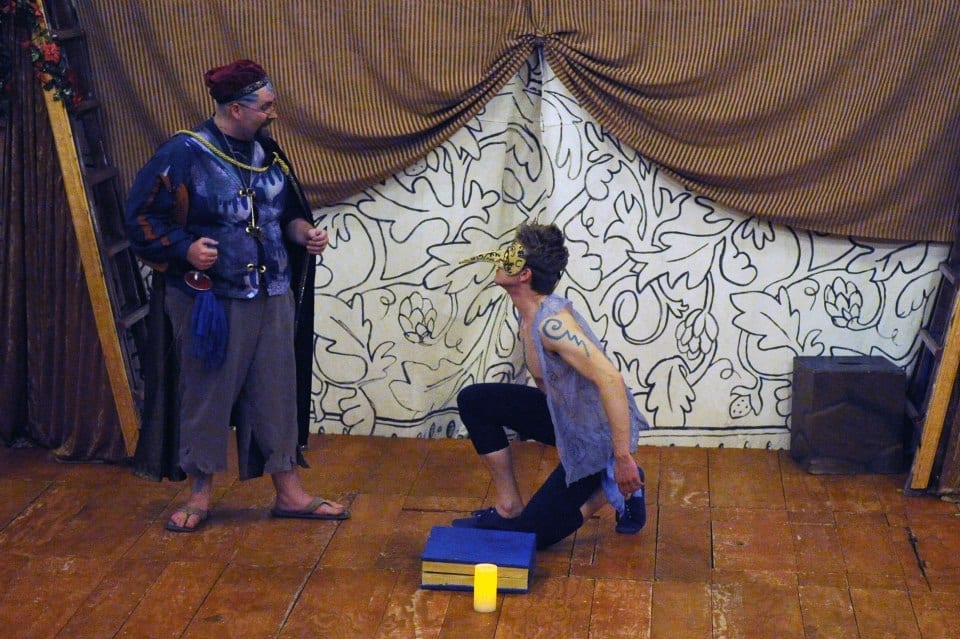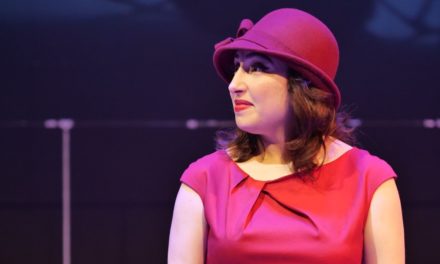 SALT LAKE CITY — Mary Poppins is a character and story I’m sure most people are, at least vaguely, aware of. It’s also a story that a lot of us probably grew up with in a special way. Mary Poppins began as a series of children’s books. The first book was published in 1934, P.L. Travers continued writing and publishing books centered around the mysterious and magical nanny and her adventures with the Banks family all the way into 1988. Eight books in total. The film, starring Julie Andrews and Dick Van Dyke, was the vehicle which I think brought Mary Poppins to the most of us, was adapted in 1964. The movie is beloved. And I think the image of Julie Andrews floating in from the sky is what a lot of people see in their minds when they first think of Mary Poppins.
SALT LAKE CITY — Mary Poppins is a character and story I’m sure most people are, at least vaguely, aware of. It’s also a story that a lot of us probably grew up with in a special way. Mary Poppins began as a series of children’s books. The first book was published in 1934, P.L. Travers continued writing and publishing books centered around the mysterious and magical nanny and her adventures with the Banks family all the way into 1988. Eight books in total. The film, starring Julie Andrews and Dick Van Dyke, was the vehicle which I think brought Mary Poppins to the most of us, was adapted in 1964. The movie is beloved. And I think the image of Julie Andrews floating in from the sky is what a lot of people see in their minds when they first think of Mary Poppins.
Mary Poppins was brought to the stage in 2004, and is appearing now at the Capitol Theater. I really had no idea what to expect. Was it going to be a straight forward adaption of the movie? (Although bringing animated horses to the stage would prove difficult.) Would it be something different entirely? Would it just make me wish I was watching the movie instead?
The show begins by introducing us, to Bert (Nicolas Dromard), the cheerful chimney sweep. The stage looks stunning, a deep blue drop in the back silhouettes Bert in an almost ethereal way. Chimneys surround him with smoke billowing to the sky. This is NOT an inexpensive set. Then, the show takes the audience into a rather fast big cast number “Cherry Tree Lane,” which introduces all the characters, specifically the Banks. With the abrupt departure of their maid Katie Nanna, the Banks were left in need of a new nanny. This opening number leads us all the way to the entrance of Mary Poppins. It felt rushed to me; grante they only have two and a half hours to tell the story. I wondered if I weren’t so familiar already with the story if I would really know what was going on and feel ready for the story to begin full throttle. Perhaps the show’s creators are counting on most people being familiar enough.
At the end of the song, Mary Poppins enters. I confess, I wished for her entrance to feel a little more grandiose. The finally of the song comes, the Banks family gathers tightly in the center of the stage, the lights go down, and when the lights come back up the family simply steps aside revealing Mary Poppins standing behind them. She simply walked on stage in the dark. I may be asking too much, but the show is called Mary Poppins. The poster image is her floating in with an umbrella. It felt a little lackluster, although the special effects later in the show, I feel, make up somewhat for this unimpressive beginning.
There must be a lot of pressure on the actress with the task to portray Mary Poppins on stage and to possibly be compared to Julie Andrews in one of her most memorable roles. I asked myself if it would it irritate me if she was impersonating the famous character? Would I be offended if she attempted something different? Right off the bat, Stephanie Leigh portrayed Mary Poppins brilliantly. She established herself, in the very first scene, as both nostalgic of what we have seen and also very much her own new version of the character. I think the right balance was achieved. Leigh’s body language and posture were stiff, and consistent, and also graceful whenever she made a turn. Never did I catch her feet not pointed outward while standing, just the way girls have always mimicked this favorite character. On the flip side, Leigh brought a sharp sarcastic element. She nipped at the family in her first line of dialogue with a delightfully caddy tone. She maintained this lovely dichotomy during the entire evening.
For the rest of the first act, many adventures ensued as the plot unfolded. While the actors and songs were all entertaining, the beginning of the show left me a bit wanting. It seemed to follow the same general structure of the movie, as far as the development of the plot and basic scenes, but with completely different elements. I wished it had either followed the movie, followed the book, or done it’s own thing. For example, Mary and the children go to the park on their first outing, they are dressed in costumes that almost perfectly resemble the costumes in the movie, the park looks the same and Bert is even working on chalk drawings, they are introduced to Bert in the same fashion as in the movie; but their first magical adventure is suddenly something very different, both in plot and visuals, than in the film. The statues of the park come alive for the big dance number “Jolly Holiday.” (The reanimated statues are a motif taken from the book.) It’s not that I expected the stage musical to be the same as the film, but it flip flopped back and forth and that made the first half seem discombobulated. All in all, I felt a bit confused with what the show’s creators were trying to do.
The “Spoonful of Sugar” number was also very different, set in a kitchen, cleaning a disastrous mess, they actually passed around a medicine bottle, taking the medicine in spoonfuls. Mrs. Banks even took the bottle in hand and took big swallows. I did not like this. The medicine was unnecessary and it was confusing. What was the purpose of the medicine?
The first act was enjoyable, but lacking in places, and it left me a little un-enthralled. The last scene before intermission was the famous “Supercalifragilisticexpialidocious” song. It was not what I expected at all, with the letters to create the word being purchased from a Cajun woman running a “talk shop” (a shop that sells conversation). The song had almost completely new lyrics. It was a little odd but very colorful, and the music and dancing was very fun to watch.
The second act was like an entirely different show; it’s brilliant and worth the cost of admission. The second half was completely different from the movie in almost every way, which worked better for me than the half-and-half approach of the former act. I was able to just enjoy the show and not feel like I was missing the movie. Mary Poppins has already left the children in the second half and a new nanny is brought in. George Bank’s childhood nanny, Miss Andrew (played by Q. Smith) is the opposite of Mary Poppins and this “Holy Terror” was a very exciting addition to the story. Smith played her excellently; her musical number “Brimstone and Treacle” was so impressive that the audience interrupted it with applause several times. Smith hit notes effortlessly and powerfully, and I think without a microphone we could have still heard her clearly. Moreover, she emoted during the song with so much hate and furry, even I felt a little nervous. Truly, Smith played the villain in a way that made you love to hate her.
The second half of Mary Poppins also featured the absolute highlight of the show, the big chimney sweep number ” Chim Chimeree/Steppin’ Time.” The song took place on rooftops, moved on stage and in front of a powerful sky backdrop. This method of presentation was very different from the movie and I appreciated the extraordinarily fresh take. A huge ensemble of sweeps dancing powerfully on the rooftops and one of the most stunning effects in the show finished the song as Bert danced upside down on the ceiling. After “Steppin’ Time,” the show moved briskly to the end, resolved the conflicts, and really capitalized on the theme of bringing the family together. Finally, the show ended with Mary Poppins opening her umbrella and floating away up and over the audience. I thought this was the perfect way to close and it was exactly what I wanted to see.
The actors and characters were all delightful. Bert, played by Nicholas Dromard, was a lovely singer and demonstrated great comic timing. The character served as sort of a guardian angel to the show, often on stage looking over a scene and helping to push the plot in deeper ways. A standout performer for me was Blythe Wilson as Mrs. Banks. I did not expect this character to be so deep and enjoyable. She went through a strong character arc, dealing with how to settle into being “just” a housewife and really finding her own way in the end. Wilson was very genuine in her portrayal and very funny at times, yet she also connected with the audience in more heartfelt moments. Laird Mackentosh as George Banks was also a favorite. He played angry and frustrated in an authentic way that felt real to me, rather than a caricature of a grumpy English banker. His singing voice also had a very velvety quality that stood out beautifully in his musical numbers.
The special effects were superb. Your mouth will drop several times. I loved the song “Let’s Go Fly a Kite” with fantastic effects that made it appear like the kite was flying without a string. I’m still not sure how they did it. Also, I was very impressed when Mary Poppins actually pulled a five foot lamp from a small carpet bag.
I was disappointed, though, in how the story was resolved on stage. In the film, George Banks is fired from the bank, but in that moment reaches his full change of heart, comes to terms with it, tells a joke and leaves. The head of the bank then dies laughing and George Banks gets his job back through a harmonious happenstance of all parties involved reaching a change of heart. I don’t want to spoil the ending of the stage musical, but it is less heartwarming. I was disappointed that it wasn’t the George’s core values that helped him through his trials and resolved the conflict.
Overall, Mary Poppins presents a worthwhile evening. This is a Broadway tour, so naturally the quality is there and the effects are out of this world. The first half was visually stunning to watch, if somewhat bipolar, and the second half was “practically perfect in every way.” This is a great show to see for fans of the movie, fans of the books, and newcomers to the whole idea of a magical floating nanny who can bring a family back together. Bring the kids and watch them marvel at what is happening right in front of their eyes. Grandma, too, will love this throwback to one of her favorite childhood characters (from the books or movie). Now, get online and get tickets before they are gone. Spit Spot!!






